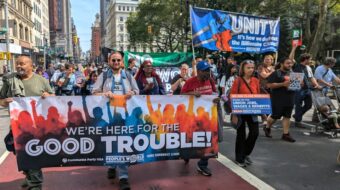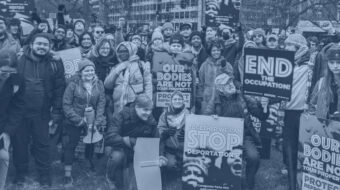Traffic congestion, polluted air and beaches, overcrowded schools, potholes, blackouts, broken water mains and decaying bridges are daily miseries that most everyone has had to confront. These hazards and disruptions will continue and in some cases worsen, according to the American Society of Civil Engineers (ASCE).
On Sept. 4, ASCE issued its 2003 Progress Report for America’s Infrastructure. It once again gave the U.S. infrastructure a grade of “discouraging D+,” showing no progress from two years ago. However, while the grade has not changed, the estimated costs to bring the nation’s infrastructure to an “adequate” level have gone up since 2001 – from $1.3 trillion to $1.6 trillion.
The report bolsters what many in the trade union and people’s movements have argued: the country needs more investment in people’s needs and the basic infrastructure.
ASCE announced “trend indicators” for 12 infrastructure categories: Roads, Bridges, Transit, Aviation, Energy, Schools, Drinkable Water, Wastewater, Dams, Solid Waste, Hazardous Waste, and Navigable Waterways.
The trends are not good, according to ASCE President Thomas Jackson, who told reporters, “We’re sliding toward failure and the prospects for improvement are grim.”
Accompanied by members of the House Transportation Committee, the ASCE president called on Congress to take urgent action on pending infrastructure legislation, in addition to “the creation of a long-term infrastructure agenda for our nation.”
Many may not consider infrastructure a glamorous issue, but it touches the lives of working families every day. “Seventy-five percent of our nation’s school buildings remain inadequate to meet the needs of school children,” the report stated. At least $127 billion, according to ASCE, is necessary to remedy overcrowded and aging facilities. And that may be a conservative estimate. The AFL-CIO states, “Repairing and upgrading schools to meet federal standards and wiring them for computers and Internet access requires at least $185 billion.”
Besides alleviating everyday miseries and hazards, investment in the infrastructure will create badly needed jobs. According to the AFL-CIO’s “Agenda to Create Jobs and Lift the Economy,” for every billion dollars invested in the transportation infrastructure an estimated 40,000 jobs are created. Using that formula, over four million jobs would be created if ASCE’s projected $1.6 trillion was invested over a 5-year period.
Gary Schaeffer, secretary-treasurer of the Ohio State Building and Construction Trade Council, told the World in a phone interview that the infrastructure is in “dire need of rebuilding.” He related how, when he lived in Akron, a chunk of concrete fell off a bridge and killed an elderly couple. “This kind of thing will happen more and more,” he said.
In Columbus, Ohio, residents recently had to deal with raw sewage because of problems with the sewer system, Schaeffer said.
The list of problems grows. “The Midwest blackout was a problem of deregulation and an old grid system,” he said.
On Labor Day, George W. Bush went to Ohio, a 2004 election battleground state, and spoke to some union members about his tax cuts (for the rich) and how they would create jobs. A week later, employers announced 93,000 jobs were slashed in August.
“President Bush was here on the worst possible day. It was raining. I heard about 1,000 people attended. Most people were disappointed, because he spoke of generalities and didn’t get into details [about jobs],” Schaeffer said.
Joe Brady, a spokesman for the International Union of Operating Engineers, told the World that investing in the infrastructure made total sense for job creation. “Thousands and thousands of good paying jobs would be created,” he said. “And when you delay addressing these problems, you increase the cost. Plus every year they delay, schools get worse, depriving our children the proper environment in which to learn.”
On Sept. 7, Bush requested another $87 billion for the cost of rebuilding and occupying Iraq and Afghanistan. This is on top of the $79 billion requested in April for the illegal war on Iraq, the almost $400 billion 2003 military budget, and the $350 billion tax giveaways to the rich. The Center on Budget and Policy Priorities said Bush’s tax policies could cost $1 trillion over the next 10 years if they are extended.
The Bush administration’s fiscal and economic policies have resulted in the largest deficit ever, $500 billion, and the largest job loss ever, over 3 million since taking office.
There was no comment from the White House on the ASCE report. But, even conservatives questioned the White House spending priorities versus the needs of the country, reflecting a growing trend. House Transportation Committee member Rep. John Duncan (R-Tenn.) told the media, “If we can spend a billion dollars or more a week in Iraq … we should be doing the same types of things for the people in this country.”
The author can be reached at talbano@pww.org









